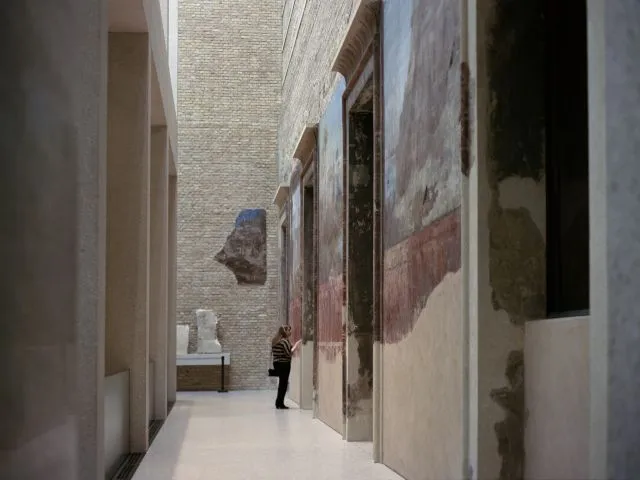新博物馆

下载所需积分: 5
位于斯普雷河岛 “Spree Island” 的博物岛 “Museum Island”,早在16世纪就开始建设,作为施塔特斯洛斯 ”Stadtschloss“ 的一座花园。由卡尔·弗里德里希·舍林克 ”Karl Friedrich Schinkel“ 设计的老博物馆 ”Altes Museum“ 于1828年完工,然后在1841年,普鲁士国王腓特烈·威廉四世 ”Friedrich Wilhelm IV“ 命令他的宫廷建筑师弗里德里希·奥古斯特·斯图勒 ”Friedrich August Stüler“ 起草了一项计划,开发老博物馆后方的土地,并建造一个“艺术与科学的圣地”。由斯图勒设计的新博物馆 ”Neues Museum“ 成为这个梦想中的圣地的第一个组成部分,建于1841年至1859年。新博物馆是第一个三层楼的博物馆,采用了一个简单的平面图,围绕两个庭院布置,取代了老博物馆中的中央圆形厅和圆顶,改建成了一个贯穿所有楼层并占据建筑物全宽度的矩形楼梯厅。
二战期间的大规模轰炸使得该建筑遭受了严重破坏,一些部分受到了严重损坏,其他部分完全被摧毁。战后几乎没有进行修复,废墟被暴露在外,东德时期只进行了最低限度的巩固和保护。1997-1998年,大卫·奇普菲尔德建筑师事务所 ”David Chipperfield Architects“ 获得了该项目的委托,建筑和修复工作历时近十一年才完成,并于1999年将整个博物岛列入了联合国教科文组织世界文化遗产名录。
该项目是独特的,因为在相对长时间的停滞期内,以前没有任何一次重建尝试是完全成功的。项目赞助人最初的意图是将博物馆设计与展示相结合,形成一种展品与展示空间之间的共生关系,但这种方法已经不再吸引当代游客,而且在许多情况下,原材料 ”包括文物和房间“ 已经不存在,特别是在原本最为明显的大型空间中,这种教学统一原本最为显著的地方。
在考虑未来发展时,很明显,这座废墟不应该被解释为全新建筑的背景,但也不应该将在战争中不可逆地丢失的部分完全重建。一个连续的结构,几乎包括了所有可用的受损构件,同时允许添加一系列现代元素,成为首选方案,通常被描述为“第三种方式”。该项目的关键目标是完成原始体量,并修复和恢复二战后幸存下来的部分。这个过程可以被描述为对所有组件进行修复、保护、恢复和重建的多学科互动。原始的房间序列经过恢复,并通过新建的部分与现有结构形成连续性。几乎是考古学式的修复遵循了《威尼斯宪章》的准则,尊重历史结构在其不同保存状态下的历史结构。所有现有结构中的空白都被填补,而不与其光亮度或表面竞争。对建筑现有元素的修复和修复是基于这样一种想法,即应强调原始结构的空间环境和材料性 - 当代反映了失去的,但没有模仿它。
新的展厅是由大型预制混凝土元件建造的,由白色水泥与撒克逊大理石碎片混合而成。由相同的混凝土元件构成,新的主楼梯重复了原始的形式理念,但没有复制它,并位于宏伟的大厅内,该大厅仅作为砖体积保存,没有了以前的装饰。其他新的体量 - 西北翼,带有埃及庭院和阿波罗升降机;希腊庭院中的半圆形拱门;和南圆顶 - 由回收的手工制作砖块建造,以补充保存的部分。
通过在新博物馆东部和南部的柱廊的恢复和完成,重新建立了战前的城市情况。在新博物馆和库普费格拉本 ”Kupfergraben“ 之间将建造一座新建筑,名为詹姆斯·西蒙画廊 ”James Simon Gallery“,呼应了该地点在1938年之前的城市情况,当时舍林克的帕克霍夫 “Packhof,海关大楼“ 面向着斯普雷河。
2009年10月,在废墟上经过六十多年后,新博物馆作为博物岛上第三座修复完成的建筑,向公众重新开放,展示了埃及博物馆和史前与早期历史博物馆的藏品。建筑物见证了其复杂的历史,一些原始的技术创新已被展示出来。其装饰图案的不完整性有助于全面理解历史和当代结构以及其原始和当前的目的。
Development of Museumsinsel (Museum Island), previously known as the Spreeinsel (Spree Island), began in the sixteenth century as a pleasure garden for the Stadtschloss (City Palace). The Altes Museum (Old Museum) by Karl Friedrich Schinkel was completed in 1828, and then in 1841 King Friedrich Wilhelm IV of Prussia ordered his court architect, Friedrich August Stüler, to draw up a plan to develop the land behind the Altes Museum – hitherto used for commercial purposes – and create a ‘sanctuary for the arts and sciences’. Designed by Stüler, the Neues Museum (New Museum) became the first component of this visionary haven, and was erected between 1841 and 1859. The Neues Museum was the first three-storey museum ever built and was organised as a solitaire construction executed according to a simple ground plan that enclosed two courtyards and replaced the central rotunda and cupola used in the Altes Museum with a rectangular stair hall that rose through all floors and occupied the full width of the building.
Extensive bombing during World War II left the building in ruins with some sections severely damaged and others completely destroyed. Few attempts at repair were made after the war, and the wreck was left exposed with only a minimum of consolidation and protection undertaken during the GDR period. After David Chipperfield Architects’ appointment to the project in 1997–98, the building and restoration took nearly eleven years to complete, and the entire Museum Island was added to the UNESCO World Cultural Heritage list in 1999.
The project was unique given that no earlier reconstruction attempt had been fully realised over a relatively long period of quiescence. Its patron’s original intention of linking museum design and presentation in a symbiotic relationship of exhibits and exhibition spaces had not only lost its appeal for the contemporary visitor but in many cases could simply no longer be created since much of the original material – both artefacts and rooms – no longer existed, especially in the larger spaces where this didactic unity was originally most apparent.
When considering the way forward, it was clear that the ruin should not be interpreted as a backdrop for a completely new architecture but neither was an exact reconstruction of what had been irreversibly lost in the war seen as an option. A single continuous structure that incorporates nearly all of the available damaged fabric while allowing a series of contemporary elements to be added became the preferred path, often described as ‘the third way’. The key aims of the project were to recomplete the original volume, and to repair and restore the parts that remained after the destruction of World War II. The process can be described as a multidisciplinary interaction between repairing, conserving, restoring and recreating all of its components. The original sequence of rooms was restored with newly built sections that create continuity with the existing structure. The almost archaeological restoration followed the guidelines of the Charter of Venice, respecting the historical structure in its different states of preservation. All the gaps in the existing structure were filled in without competing with its brightness or surface. The restoration and repair of the existing elements of the building were driven by the idea that the spatial context and materiality of the original structure should be emphasised – the contemporary reflects the lost but without imitating it.
The new exhibition rooms are built of large-format prefabricated concrete elements consisting of white cement mixed with Saxonian marble chips. Formed from the same concrete elements, the new main staircase repeats the formal idea of the original without replicating it, and sits within the majestic hall that is preserved only as a brick volume, devoid of its former ornamentation. Other new volumes – the north-west wing, with the Egyptian court and the Apollo risalit; the apse in the Greek courtyard; and the South Dome – are built of recycled handmade bricks, complementing the preserved sections.
With the reinstatement and completion of the mostly preserved colonnade at the eastern and southern sides of the Neues Museum, the pre-war urban situation is re-established to the east. A new building, the James Simon Gallery, will be constructed between the Neues Museum and the Kupfergraben, echoing the urban situation of the site pre-1938 when Schinkel’s Packhof (Customs House) faced the Spree.
In October 2009, after more than sixty years as a ruin, the Neues Museum reopened to the public as the third restored building on Museum Island, exhibiting the collections of the Egyptian Museum and the Museum of Pre- and Early History. The building bears witness to its complex history while some of its original technological innovations have been laid bare. The very incompleteness of its decorative pattern helps to create a holistic understanding of the historic and contemporary structure and its original and current purpose.